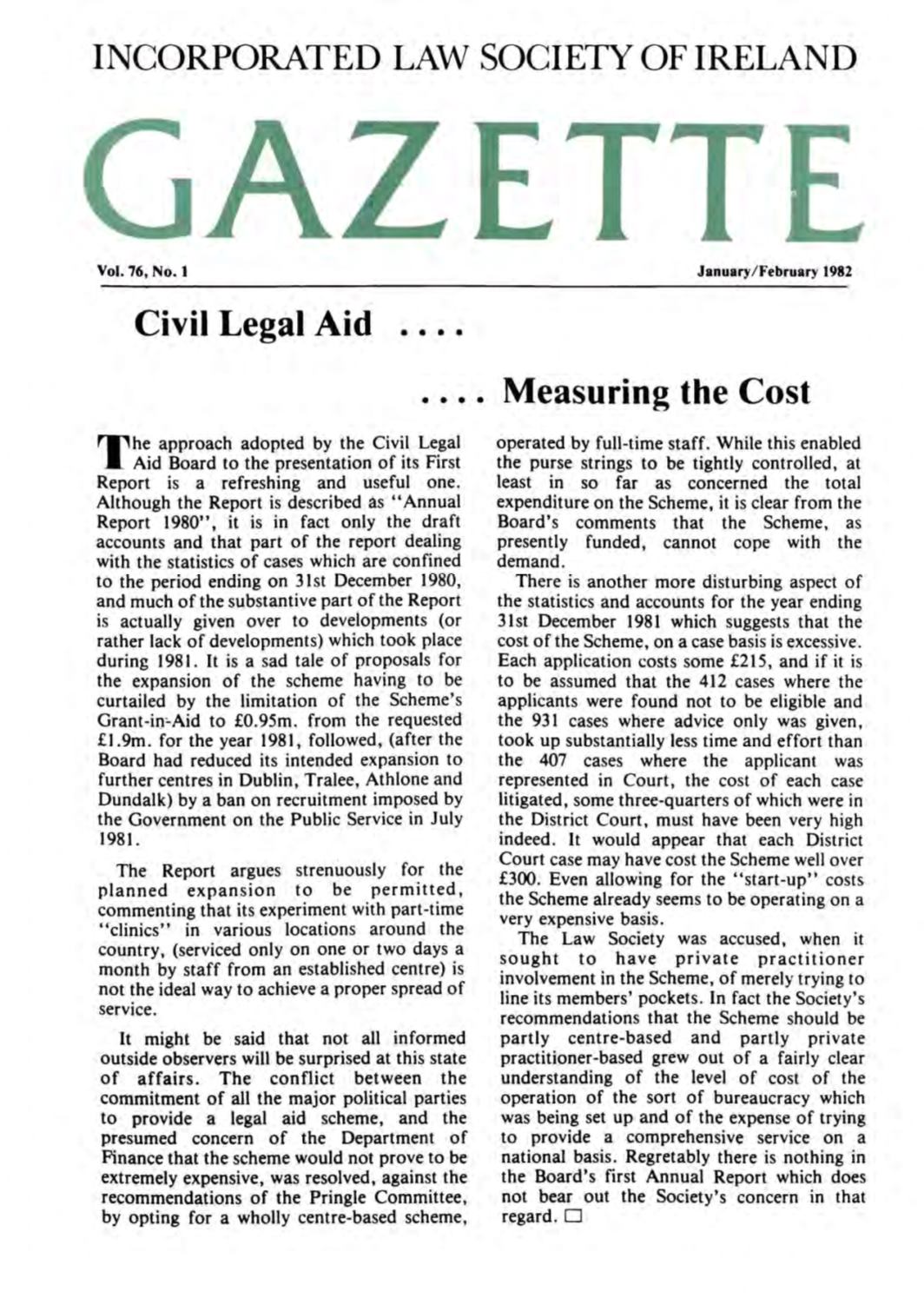

INCORPORATED LAW SOCIETY OF IRELAND
Vol. 76, No.1
Civil Legal Aid
• • •
•
• • •
•
T
he approach adopted by the Civil Legal
Aid Board to the presentation of its First
Report is a refreshing and useful one.
Although the Report is described as "Annual
Report 1980", it is in fact only the draft
accounts and that part of the report dealing
with the statistics of cases which are confined
to the period ending on 31 st December 1980,
and much of the substantive part of the Report
is actually given over to developments (or
rather lack of developments) which took place
during 1981.
It
is a sad tale of proposals for
the expansion of the scheme having to be
curtailed by the limitation of the Scheme's
Grant-in--Aid to £O.95m. from the requested
£1.9m. for the year 1981, followed, (after the
Board had reduced its intended expansion to
further centres in Dublin, Tralee, Athlone and
Dundalk) by a ban on recruitment imposed by
the Government on the Public Service in July
1981.
The Report argues strenuously for the
planned expansion to be permitted,
commenting that its experiment with part-time
"clinics" in various locations around the
country, (serviced only on one or two days a
month by staff from an established centre) is
not the ideal way to achieve a proper spread of
service.
It
might be said that not all informed
outside observers will be surprised at this state
of affairs. The conflict between the
commitment of all the major political parties
to provide a legal aid scheme, and the
presumed concern of the Department of
Finance that the scheme would not prove to be
extremely expensive, was resolved, against the
recommendations of the Pringle Committee,
by opting for a wholly centre-based scheme,
January/February 1982
Measuring the Cost
operated by full-time staff. While this enabled
the purse strings to be tightly controlled, at
least in so far as concerned the total
expenditure on the Scheme, it is clear from the
Board's comments that the Scheme, as
presently funded, cannot cope with the
demand.
There is another more disturbing aspect of
the statistics and accounts for the year ending
31 st December 1981 which suggests that the
cost of the Scheme, on a case basis is excessive.
Each application costs some £215, and if it is
to be assumed that the 412 cases where the
applicants were found not to be eligible and
the 931 cases where advice only was given,
took up substantially less time and effort than
the 407 cases where the applicant was
represented in Court, the cost of each case
litigated, some three-quarters of which were in
the District Court, must have been very high
indeed.
It
would appear that each District
Court case may have cost the Scheme well over
£300. Even allowing for the "start-up" costs
the Scheme already seems to be operating on a
very expensive basis.
The Law Society was accused, when it
sought to have private practitioner
involvement in the Scheme, of merely trying to
line its members' pockets. In fact the Society's
recommendations that the Scheme should be
partly centre-based and partly private
practitioner-based grew out of a fairly clear
understanding of the level of cost of the
operation of the sort of bureaucracy which
was being set up and of the expense of trying
to provide a comprehensive service on a
national basis. Regretably there is nothing in
the Board's first Annual Report which does
not bear out the Society's concern in that
regard.
0
















